» Home
» About
» Membership
» Journal
» Sparoza Garden
» Branches
» MGS Forum
» Seed Exchange
» Donations
» MGS Excursions
» Information
» Members' Gardens
» Book Reviews
» News & Views
» Contact
» Search
|
Nangkita 'Place of Little Frogs'
Riddells Creek, Victoria, Australia
We built our timber house 17 years ago on half an acre and began to make the garden shortly afterwards. We live in a little town at the foothills of the Macedon Ranges in Central Victoria about 55km north-east of Melbourne. The soil is 20cm of silty sand overlying silty clay. The rainfall over the last 120 years has averaged 623mm per year, but over the last 14 years this has dropped sharply to 380mm. Temperatures range from below zero in winter to 46ºC. Blame drought or blame climate change - it simply means that the garden we designed and planned for no longer exists and we have had to change our gardening accordingly.
One third of the garden is given over to exotics, one third to Australian native plants and the third that surrounds the original farm dam comprises the vegetable garden, orchard, nursery, compost bins, wood shed and chicken run. The first thing I did after designing the layout of the garden beds was to get in a "Bobcat" and shift some imported soil into low mounds as I was worried about the poor drainage on the flat land. Hah! Drainage is not the problem - getting moisture into the soil is now the problem.
Originally all the plants were on drip irrigation - individual drippers for the Australian natives and a water weeping hose for the remainder. Both systems are no longer operational. The vegetable garden was originally watered by overhead sprinklers (now a distant memory) but is now watered by in-line drip irrigation on a timer. We have had water restrictions here on and off for 11 years so we do pump from the dam in the latter weeks of summer. The dam is filled from the roof of the house as it no longer receives overland flow.
We used to have green lawns on the northern side of the house because that is the direction from which a bushfire would come, but water restrictions mean that watering lawns is no longer allowed. I am currently trying to decide whether to replace the lawn (composed of cool season water-guzzling grasses) with a warm season more drought tolerant couch grass (Cynodon dactylon) or whether just to put in artificial turf (gaining popularity here) or gravel. Green lawns do set off garden beds well, but they are going the way of the dodo in the drier parts of Australia.
The last few years have been spent pulling out the dead and dying plants (that obviously needed too much water) and replacing them with more drought-tolerant species. A copse of three Acer 'Sango Kaku' has given way to a pomegranate and salvias have replaced Monarda. Aptenia cordifolia is proving to be a terrific living mulch, as is Euphorbia robbiae. My national collection of Hebes for the Garden Plants Conservation Association of Australia is going to be shifted elsewhere because I cannot give them enough water. They have suffered over the last few years - particularly the heat of last summer.
An embryonic fondness for succulents has grown into a full-blown love affair and my garden now features many different species. My current obsession is with the genus Aeonium and I now have about 10 species. My aim is to find the species with the biggest rosette after having seen some really big ones in California. They are really tough and grow madly during winter and spring, then going dormant over the long hot summer. They don't seem to be frost-sensitive either although our frosts are not that bad here.
So this is my garden in Central Victoria: a garden adapting to climate change and becoming more mediterranean by the day.
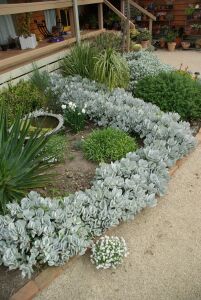
A ribbon of the silver-grey Cotyledon orbiculata weaves its way around a clump of the dwarf Agapanthus 'Snowball' and a clump of white narcissus. The starburst form of Furcraea bedinghausii to the left is getting bigger by the day and a Beaucarnea recurvata is rising above a Cistus salviifolius and Helichrysum petiolare to its right. To its left are the strappy leaves of Dietes grandiflora and up against the steps is Strobilanthes gossypinus, the trunk of Pseudopanax crassifolius and an Echinocactus grusonii in a tall pot. Behind the water bowl is a white cytisus and the green leaves of Ruscus hypoglossum.
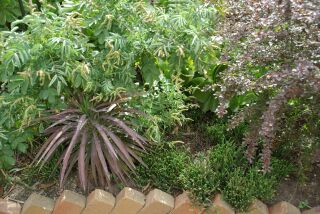
Dendropoterium menendezii (from the Canary Islands) is on the left just coming in to flower and it overhangs a mulberry-coloured Yucca desmetiana. Berberis thunbergii 'Atropurpurea' is on the right. Between the yucca and the berberis is Crassula lycopodioides which makes a great groundcover in part shade. Behind it are the large succulent leaves of Cotyledon macrantha.
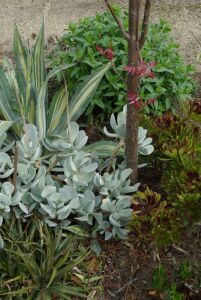
At the base of Cedrela sinensis (syn. Toona sinensis) clockwise from the top left hand corner is an Agave americana 'Mediopicta Alba Striata', the new shoots of Centranthus ruber, Aeonium arboreum 'Atropurpureum', the hard to propagate Limonium peregrinum, Dyckia sp. and Cotyledon orbiculata.
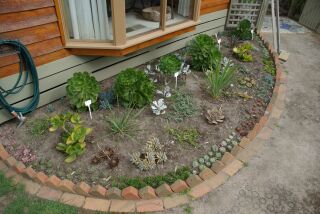
The big green rosettes of my labelled aeonium collection are planted against the house and a selection of echeverias and sempervivums are being trialled in a double row as an edging plant beside the bricks. Also in this bed from the left are Agapanthus 'Snowball', Cotyledon macrantha, Yucca sp., Echeveria 'Black Prince', a dudleya (I think), Cotyledon orbiculata 'Silver Waves', a corpuscularia and Beschorneria yuccoides.
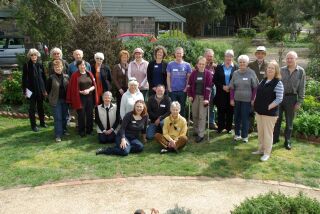
Members and friends of the Victorian branch of the MGS in September 2009 in our garden. I am sitting on the lawn in the front row in blue jeans and a grey shirt.
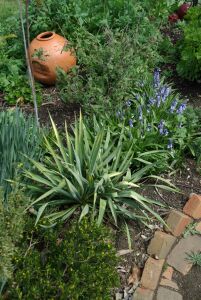
On the extreme left there is a branch of Juniperus x media 'Plumosa Aureovariegata' then Cneorum tricoccon (the spurge olive) and Yucca 'Golden Sword' with some narcissus foliage to its left. To the right of the yucca are some Spanish bluebells (Hyacinthoides hispanica). Behind it is Salvia 'Anthony Parker' and behind it (obscured by Flanders poppies) is Ceanothus gloriosus. The stick near the narcissus is the trunk of Arbutus canariensis.
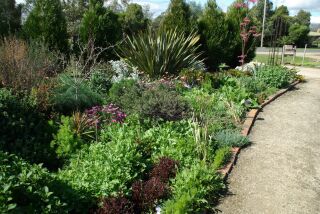
Looking towards the front gate at the back is a hedge of Thuja plicata 'Fastigiata' which replaced an enormous hedge of Cupressus macrocarpa. Clockwise from the top left-hand corner you can see a Deutzia gracilis then a Crataegus tanacetifolia with Ferula communis at its feet. Then an echium, Hebe cupressoides, an arctotis in sunset shades as well as a purple Osteospermum. Behind all this is a giant form of Phormium tenax. Moving right cedrela, agave and centranthus as in photo no. 3. Then amidst the masses of seedlings of Flanders poppies and nigella the large leaves are of Salvia forskaohlei, various small salvias, sedums, echeverias, Teucrium scorodonia 'Crispum Marginatum', Cistus sp. and the purple tips of a pink Gaura. Bottom left is Teucrium betonicum, Cistus 'Brilliancy' and to its right Cordyline 'Albertii'. There is a tamarix, an 'Amber' flower carpet rose and Verbena bonariensis in there somewhere.
|


